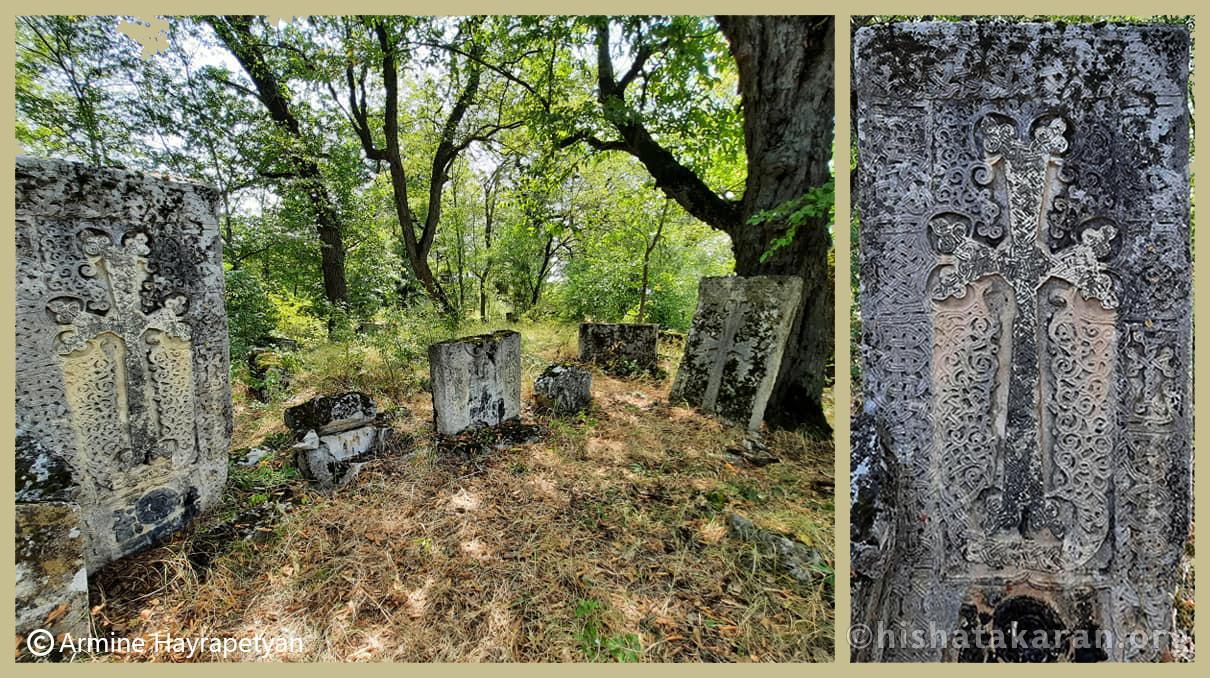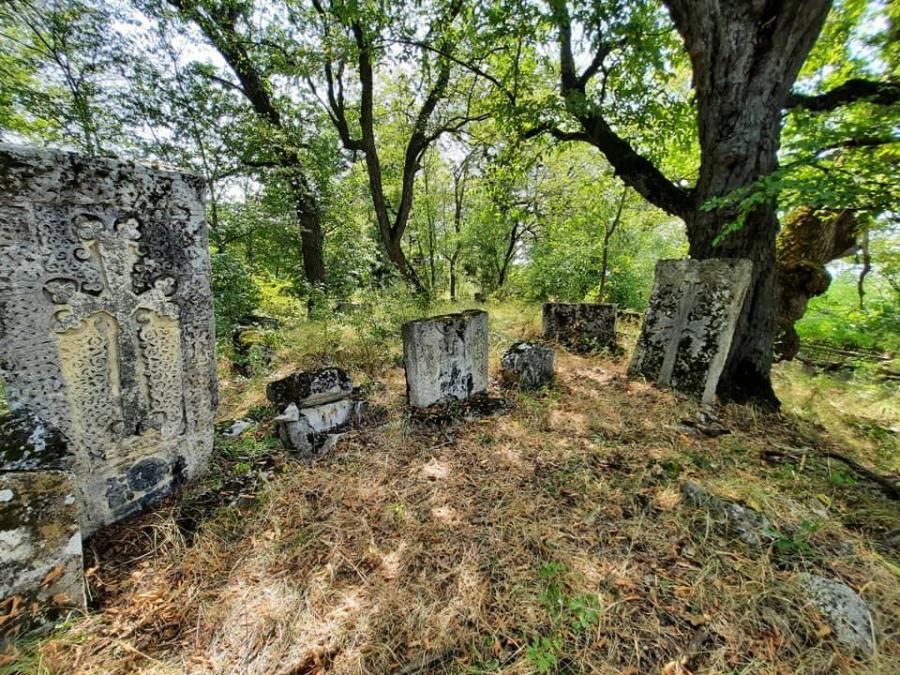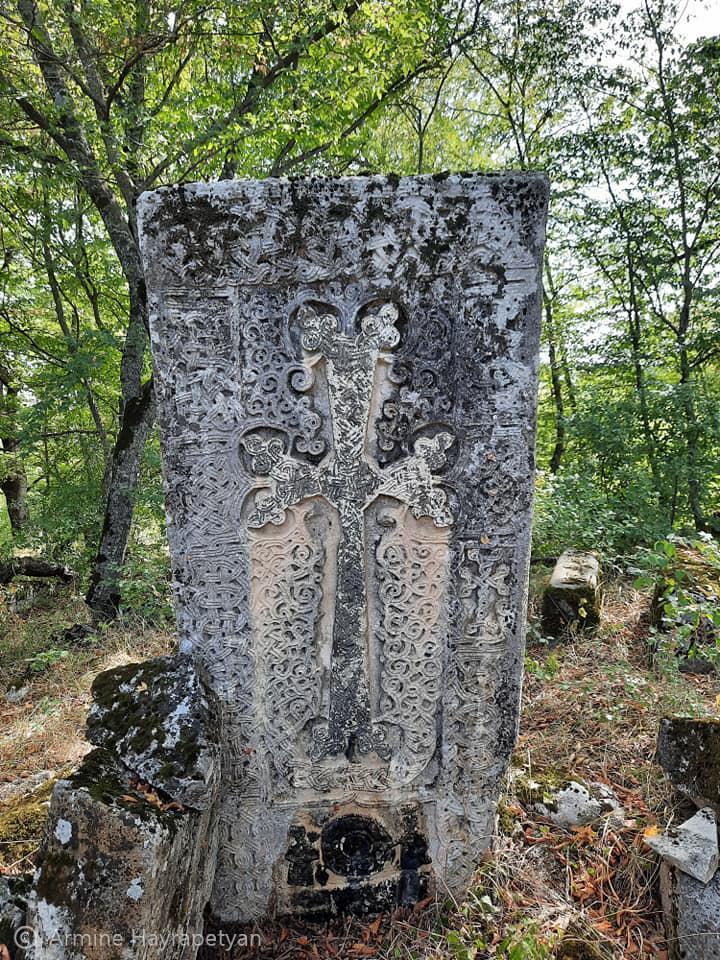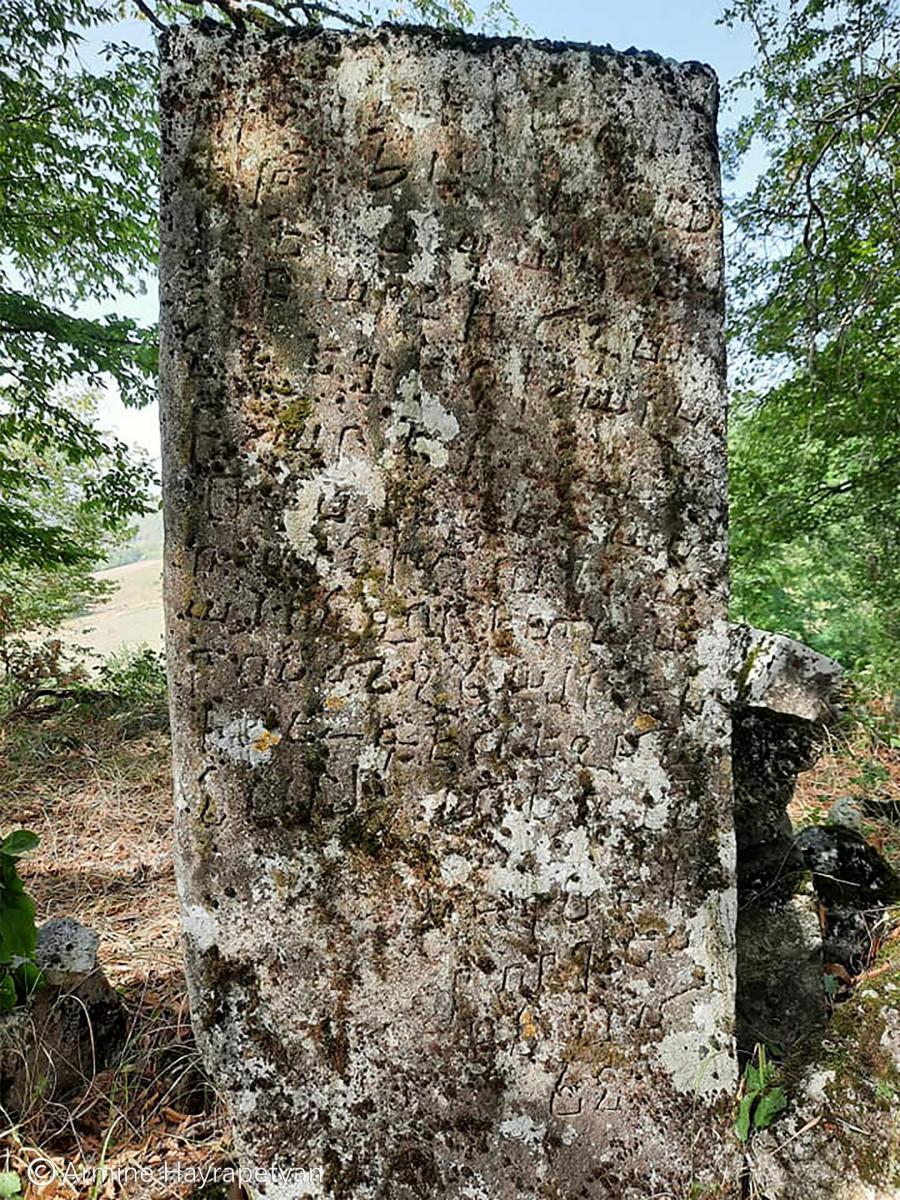
Karaglukh [Kʻaraglukh] hamlet, Khachin Khut [Khachʻin khutʻ] cemetery, khachkar № 1
Monument
Monument type
Khachkar initial, sequential and current
The khachkar was erected in 1253 by Snbat and his brothers. From the Soviet era until 2022, it served as a sacred site.
A topographic report
Region, community, settlement
Mets Aṛankʻ Province (later Khachʻen) of the Artsakh, historical Greater Armenia. Until 2020: Republic of Artsakh, Askeran region, Khramort [Khramortʻ] village, Karaglukh [Kʻaraglukh] hamlet.
Distance and location from community
It is located at the southwestern edge of Kʻaraglukh, in the Khachʻin Khutʻ area.
Site elevation above sea level
It is 1050 meters above sea level. Hydrography
It is located 4 km south of the Khach‘enaget (river), on the southern side of Mount Shikakʻar. Description
The khachkar is located in the relatively elevated central part of the Khachin Khut [Khachʻin Khutʻ] cemetery. It stands out for its large dimensions (1.73x0.82x0.24), style, iconography, and the 16-line inscription carved on the back of the khachkar: "Թի(վն) ։ՉԲ։ (1253). իշխանո|ւթի․ Հասանա|յ․ ես Սնպատ եւ|եղբարք իմ կա|նկ(ն)եցի զխաչս| բարէխաւս | ա|ռ Ք[րիստո]ս․ ինձ եւ ամ|ուսին իմոյ Կատ|ային․ զոր ետ պա|րոն մեզ հայրեն|իք եւ գերեզմա|նայտեղ․ ՔՍ | աւգնե իւ|ր որդեա|ցն․ Ամ|են" ( In the year 1253, under the rule of Hasanay, I, Snpat, and my brothers erected this intercessory cross before Christ, who gave us a homeland and a place of burial, for myself and my wife Katay. May God help our children. Amen.)1.
At the center of the composition, beneath a rectangular cross-niche, is a large floral cross, fully adorned with intricate carvings, with triple-bud ends on the arms. From the center of the base of this cross, intertwining branches extend to the right and left, growing upwards and merging with the horizontal arms of the cross, covering the entire intervening field with elegant carvings. Similarly, from the top center of the vertical cross-arm, delicate floral decorations descend, filling the entire field, separated from the cross by a narrow, deep-carved band. Notably, this deep-carved section does not directly follow the outline of the cross but creates a new contour with a new cross design, where the pair of arms" protrusions are circular (similar examples include the khachkars of the Anahit"s Fontaine in the Hats‘i village, khachkar № 7, of Kuchir Shal cemetery in Kʻaraglukh, the khachkar № 2 of the Khachʻin Khutʻ cemetery, as well as the 13th-century khachkars of Vardadzor village).
Below the central cross, in the lower part of the pedestal, is a family relief carving depicting a memorial meal. It likely represents Snpat2, mentioned in the inscription, his wife Katay, and their child. Next to the woman"s relief carving is a wine jug, and in the man"s hand is a cup.
The cross-niche is bordered from above and on both sides by an intricately woven decorative band, within which, on the right side, there is another small woven cross-carving.
Historical record
Cultural characteristics, period, century (centuries)
Principality of Khachen, Armenian Apostolic Church, year 1253.
Documents for dating: Justification of the date based on epigraphy.
According to the inscription on the khachkar
Chronological table of monument
The khachkar was erected in the 13th century, in the year 1253. Snpat"s grave had become a sort of sanctuary for the locals.
The village was occupied by the Azerbaijani army on March 24, 2022. According to satellite images from 2023, Azerbaijani soldiers have transformed the area of the Khachin Khut [Khachʻin khutʻ] cemetery into a military outpost. Trenches and bunkers have been dug in the area. The fate of the monument is unknown.
Chronological table of research on the monument (period, author, works)
Descriptive-Characterization Report
Building material (type, colour)
It is carved from flint stone.
Dimensions: width
0,82 m Dimensions: height
1,73 m Dimensions: depth, thickness
0,24 m State of conservation: Qualitative (good, average, bad, emergency, ruins)
Good (Before the village was occupied, the khachkar stood in its original place.)
Value
The monument is one of the finest examples of khachkar craftsmanship in Artsakh. It, along with a group of similar 13th-century Artsakh khachkars, is distinguished by unique iconographic traditions and stylistic features. The inscription on the khachkar serves as an important historical document, providing valuable information about the past of Karaglukh [village and its inhabitants. ----------------------------
1Barkhudaryan S., 1982, p. 140.2The same is Smbat
Photos



...
Main bibliography
Բարխուդարյան Ս․, 1982 - Բարխուդարյան Սեդրակ, Դիվան հայ վիմագրության, Արցախ, պրակ 5, Երևան, 1982 [Barkhudaryan Sedrak, Divan hay vimagrut’yan, Arts’ax (Corpus of Armenian Epigraphy, Artsakh), volume 5, Erevan, 1982].
Ջալալյանց Ս․, 2016 - Ջալալյանց արքեպիսկոպոս Սարգիս, Ճանապարհորդություն ի մեծն Հայաստան, Երևան, 2016 [Jalalyants’ ark’episkopos Sargis, Chanaparhordut’yun i metsn Hayastan (Journey to Greater Armenia), Erevan, 2016].
Мкртчян Ш.,1988 - Мкртчян Шаген, Историко-Архитектурные памятники Нагорного Карабага, Ереван, 1988 (Historical and Architectural Monuments of Nagorno-Karabakh), Erevan,1988].
.
A․H․, A․ L-Y․
